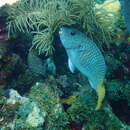Diagnostic Description
provided by Fishbase
Juveniles and adults in drab phase (which are either mature males or females) are light grayish brown, nearly white ventrally; alternate dark and pale bars cross the chin; caudal peduncle and fin yellow; anal and pelvic fins red. Terminal phase males are dull green or blue-green with a large black spot on upper half of pectoral fin base; pectoral fins dark olive, the outer fifth abruptly pale (Ref. 13442).
- Recorder
- Cristina V. Garilao
Life Cycle
provided by Fishbase
Although protogyny was propossed for this species (Ref. 27876), probably because testicular characteristics showed a secondary characteristic of sex-changed males, observations of overlapping size ranges of males and females, and males maturing at the same ages and sizes as did females, strongly suggest gonochorism (Ref. 103751). A monandric species (Ref. 55367). Length at sex change = 25.0 cm TL (Ref. 55367). Forms leks during breeding (Ref. 55367).
Morphology
provided by Fishbase
Dorsal spines (total): 9; Dorsal soft rays (total): 10; Analspines: 3; Analsoft rays: 9
- Recorder
- Cristina V. Garilao
Trophic Strategy
provided by Fishbase
Inhabits coral reefs and seagrass beds. Juveniles or primary-phase fish can rapidly assume a mottled pattern as it comes to rest on the bottom. Herbivore (Ref. 57616).
Biology
provided by Fishbase
Inhabits coral reefs and seagrass beds. Juveniles or primary-phase fish can rapidly assume a mottled pattern as it comes to rest on the bottom. Spawning is usually a group activity in similarly colored males and females (Ref. 5521). A protogynous hermaphrodite (Ref. 55367).
Importance
provided by Fishbase
fisheries: minor commercial; aquarium: commercial; price category: high; price reliability: very questionable: based on ex-vessel price for species in this family
Sparisoma rubripinne
provided by wikipedia EN
Sparisoma rubripinne, which also goes by the common names yellowtail parrotfish or redfin parrotfish is a species of parrotfish in the genus Sparisoma.[1] It can be found in the Western Atlantic Ocean, and is primarily found in the Caribbean Sea.[2]
Description
Sparisoma rubripinne is a medium-sized parrotfish that grows to a maximum length of 47.8 cm.[3] Juveniles and initial-phased adults are a drab silver-tan with a barred pattern on the scales. Additionally, juveniles and initial-phased adults have a bright yellow caudal peduncle and caudal fin. In contrast, terminal phase males are a dull blueish-green with a large black spot on the pectoral fin base.
Biology
Sparisoma rubripinne inhabits coral reefs and seagrass meadows in the Western Atlantic Ocean. Here, it can be found from depths of 1–15 meters deep.[4]
References

- license
- cc-by-sa-3.0
- copyright
- Wikipedia authors and editors
Sparisoma rubripinne: Brief Summary
provided by wikipedia EN
Sparisoma rubripinne, which also goes by the common names yellowtail parrotfish or redfin parrotfish is a species of parrotfish in the genus Sparisoma. It can be found in the Western Atlantic Ocean, and is primarily found in the Caribbean Sea.
- license
- cc-by-sa-3.0
- copyright
- Wikipedia authors and editors
Distribution
provided by World Register of Marine Species
Western Atlantic: Massachusetts, USA and Bermuda to Río de Janeiro, Brazil; throughout the Caribbean Sea but absent in the Gulf of Mexico
North-West Atlantic Ocean species (NWARMS)
- license
- cc-by-4.0
- copyright
- WoRMS Editorial Board

